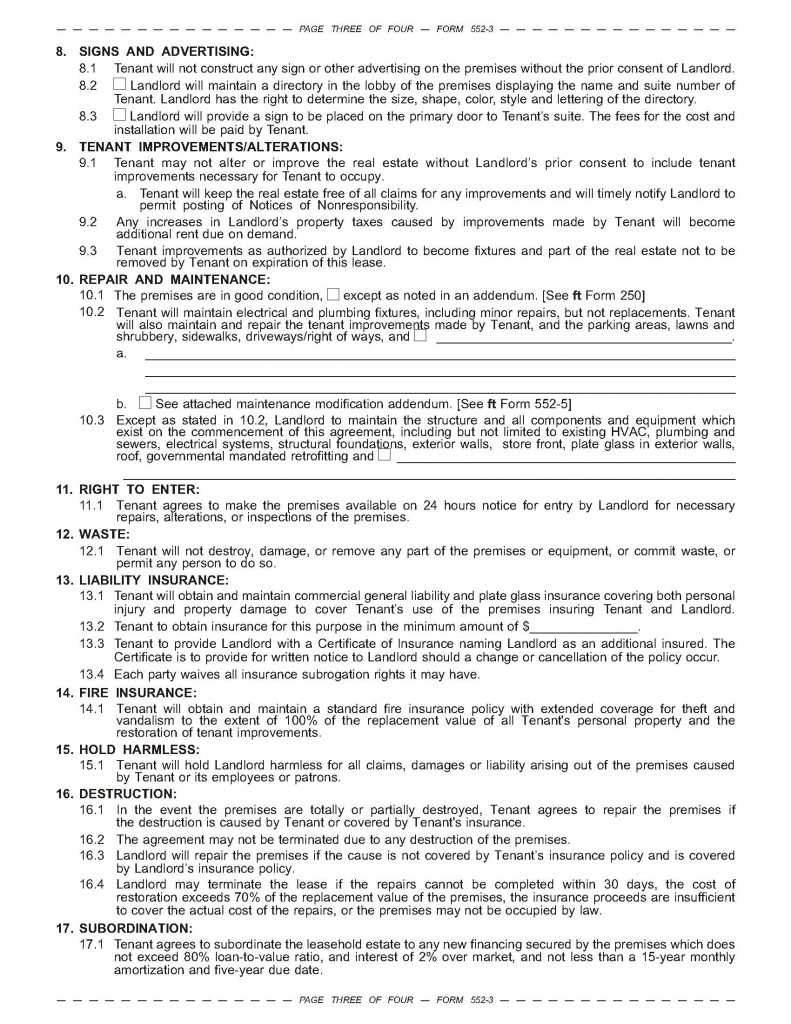Form-of-the-week: Nonresidential Lease Agreement — Commercial, Industrial Gross – Single Tenant – Form 552-3
All nonresidential rental and lease agreements now include an Americans With Disabilities Act (ADA) disclosure. Without it, landlords expose themselves to tenant litigation for fraud (or indemnity) when the tenant is hit with an ADA violation claim.
An ADA risk compliance disclosure provision is included in first tuesday’s nonresidential lease agreements since California’s Disabled Access Law makes disclosure of ADA conditions a material fact. To avoid misrepresenting property conditions, a nonresidential lease agreement needs to declare whether the property has undergone an inspection by a Certified Access Specialist (CASp). Further, if the property has been inspected, a statement whether it does or does not meet ADA standards is included.
While the landlord needs to disclose ADA conditions, they need not obtain a CASp inspection. It is the failure to make ADA disclosures, as with code violations, which exposes the landlord to claims of fraud. [Calif. Civil Code §1938 and §55.53]
A compliant gross lease
A lease agreement entered into by a landlord and tenant:
- serves as a leasehold grant;
- is evidence of tenant obligations to pay money; and
- places responsibility for the care and maintenance of the real estate.
The grant provision in a lease agreement conveys a possessory interest in the leased premise, called a leasehold estate, or simply a lease, leaving the landlord with a reversionary interest in the property. [CC §761(3)]
By entering into a lease agreement and delivering possession to the tenant, the landlord conveys to the tenant the exclusive right to occupy a parcel of real estate, or space in a parcel, for a fixed period of time. The continued right of the tenant to occupy the real estate, documented in the lease, is conditioned on the tenant’s performance under the lease agreement, such as the payment of rent and maintenance of the property as agreed. [See first tuesday Form 552-3]
For a lease agreement to be enforceable when conveying a term of occupancy exceeding one year, it needs to be memorialized in a signed writing, a requirement of the statute of frauds. Thus, lease agreement forms are used to document leasing transactions. [CC §1624(a)(3)]
first tuesday’s Nonresidential Lease Agreement — Commercial, Industrial Gross – Single Tenant is worded to be user-friendly. As with all gross lease arrangements, maintenance and repair responsibilities lie primarily with the landlord. [See first tuesday Form 552-3]
To modify a gross lease, negotiations merely shift the maintenance responsibilities, item by item, from landlord to tenant. Creating a modified-gross lease agreement is easily done. Check the itemized maintenance provisions in a Maintenance Modification Addendum and attach it to the gross lease agreement. [See first tuesday Form 552-5]
The structure of an operative lease agreement
A nonresidential lease agreement has five main sections:
- identification of the parties and the premises, and the conveyance and duration of possession;
- the sums due and terms for their payment as obligations of the tenant;
- the responsibility for care and maintenance of the leased property;
- miscellaneous provisions for circumstances peculiar to the transaction; and
- the signatures of the parties.
The identification section of a lease agreement includes:
- the names of the landlord and the tenant;
- a description of the leased premises;
- words of conveyance of the leased property;
- a receipt for prepaid rents and the security deposit; and
- a list of the addenda which contain exhibits or additional terms. [See first tuesday Form 552-3]























